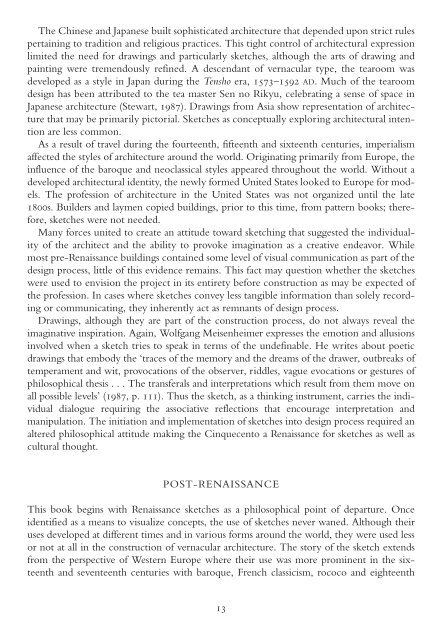Architect Drawings : A Selection of Sketches by World Famous Architects Through History
You also want an ePaper? Increase the reach of your titles
YUMPU automatically turns print PDFs into web optimized ePapers that Google loves.
The Chinese and Japanese built sophisticated architecture that depended upon strict rules<br />
pertaining to tradition and religious practices. This tight control <strong>of</strong> architectural expression<br />
limited the need for drawings and particularly sketches, although the arts <strong>of</strong> drawing and<br />
painting were tremendously refined. A descendant <strong>of</strong> vernacular type, the tearoom was<br />
developed as a style in Japan during the Tensho era, 1573–1592 AD. Much <strong>of</strong> the tearoom<br />
design has been attributed to the tea master Sen no Rikyu, celebrating a sense <strong>of</strong> space in<br />
Japanese architecture (Stewart, 1987). <strong>Drawings</strong> from Asia show representation <strong>of</strong> architecture<br />
that may be primarily pictorial. <strong>Sketches</strong> as conceptually exploring architectural intention<br />
are less common.<br />
As a result <strong>of</strong> travel during the fourteenth, fifteenth and sixteenth centuries, imperialism<br />
affected the styles <strong>of</strong> architecture around the world. Originating primarily from Europe, the<br />
influence <strong>of</strong> the baroque and neoclassical styles appeared throughout the world. Without a<br />
developed architectural identity, the newly formed United States looked to Europe for models.<br />
The pr<strong>of</strong>ession <strong>of</strong> architecture in the United States was not organized until the late<br />
1800s. Builders and laymen copied buildings, prior to this time, from pattern books; therefore,<br />
sketches were not needed.<br />
Many forces united to create an attitude toward sketching that suggested the individuality<br />
<strong>of</strong> the architect and the ability to provoke imagination as a creative endeavor. While<br />
most pre-Renaissance buildings contained some level <strong>of</strong> visual communication as part <strong>of</strong> the<br />
design process, little <strong>of</strong> this evidence remains. This fact may question whether the sketches<br />
were used to envision the project in its entirety before construction as may be expected <strong>of</strong><br />
the pr<strong>of</strong>ession. In cases where sketches convey less tangible information than solely recording<br />
or communicating, they inherently act as remnants <strong>of</strong> design process.<br />
<strong>Drawings</strong>, although they are part <strong>of</strong> the construction process, do not always reveal the<br />
imaginative inspiration. Again, Wolfgang Meisenheimer expresses the emotion and allusions<br />
involved when a sketch tries to speak in terms <strong>of</strong> the undefinable. He writes about poetic<br />
drawings that embody the ‘traces <strong>of</strong> the memory and the dreams <strong>of</strong> the drawer, outbreaks <strong>of</strong><br />
temperament and wit, provocations <strong>of</strong> the observer, riddles, vague evocations or gestures <strong>of</strong><br />
philosophical thesis ...The transferals and interpretations which result from them move on<br />
all possible levels’ (1987, p. 111). Thus the sketch, as a thinking instrument, carries the individual<br />
dialogue requiring the associative reflections that encourage interpretation and<br />
manipulation. The initiation and implementation <strong>of</strong> sketches into design process required an<br />
altered philosophical attitude making the Cinquecento a Renaissance for sketches as well as<br />
cultural thought.<br />
POST-RENAISSANCE<br />
This book begins with Renaissance sketches as a philosophical point <strong>of</strong> departure. Once<br />
identified as a means to visualize concepts, the use <strong>of</strong> sketches never waned. Although their<br />
uses developed at different times and in various forms around the world, they were used less<br />
or not at all in the construction <strong>of</strong> vernacular architecture. The story <strong>of</strong> the sketch extends<br />
from the perspective <strong>of</strong> Western Europe where their use was more prominent in the sixteenth<br />
and seventeenth centuries with baroque, French classicism, rococo and eighteenth<br />
13




